After setting up a pig-based restaurant, Allegra McEvedy went to the slaughterhouse that would process her meat. How was it?
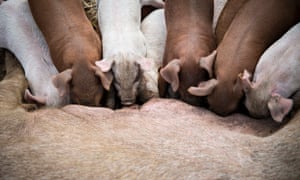
You might think that having chopped up and cooked up as much meat as I have in my life that I would take a slaughterhouse in my stride. The truth is that despite being a toughie in the kitchen, I’m really the kind of chef who would always rather someone else lowered the lobster into the pot of boiling water. I’m fine with dead animals, but the point at which animals cross from living to lunch is one that makes me wobble a bit.
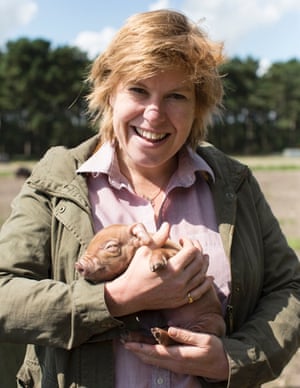
But last year, as part of the pre-launch research for my new restaurant Blackfoot, I visited the abattoir where our meat would be coming from, and this week I went back.
The sole purpose of Blackfoot is to venerate the pig in all its manifold glory. We opened last December, and so my business partner Tom Ward and I spent most of last summer very happily trudging around fields of pigs and cuddling day-old piglets all over the country. We knew what was important to us and kept going until we found farms that fitted with our welfare standards and integrity values, as well as simply producing consistently great tasting meat. When we met Mark Heywood of Dingley Dell Farm in Suffolk, we instantly knew we had our man, and our pigs.
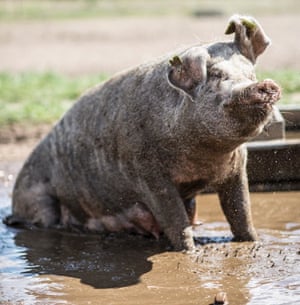
Heywood and his brother Paul run a very progressive outfit now, but the family business they inherited from their dad was a traditional, intensive pig farm. I ask Mark where his dad used to send his pigs for slaughter: “In the old days the farmer had choices: livestock markets, abattoirs or direct to butchers. These days with the huge rise of the supermarkets, most meat in this country will end up on their shelves via one of a handful of abattoirs. For most of them, there’s no choice.”
Due to the nature of Dingley Dell’s specialised outdoor farming – supplying some of the best restaurateurs in London such as Galvin, Jason Atherton and Ramsey – they do have a choice, and they use a local, mid-size abattoir, run by another two brothers – Chris and Kevin Burrows. As part of the pre-Blackfoot pig research, I felt that I really needed to see how our pigs met their maker, and so we drove the 40-minute journey to the Burrows abattoir with a growing knot in my tum; despite being in the food business for 20-odd years, this was to be my first slaughterhouse.
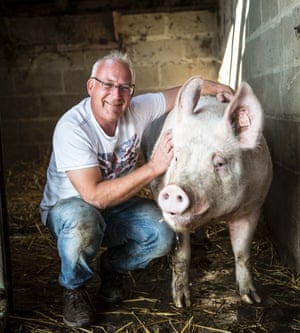
Although I really did want to see this missing piece between farm and restaurant back door, I wasn’t exactly rushing out of the car when we pulled up outside a completely normal looking, if rather large, unit on an industrial estate. I took a deep breath, expecting it to smell like death, exhaled gratefully when it just smelt like Suffolk, and in we went.
Walk rounds have to start at the end of the process and finish with the “high care” area, which is where the pigs are still alive. For this most recent visit the business development manager, Graham Pentelow, shows us round, waiting patiently while we get suited, booted and sanitised to within an inch of our lives.
We go round the corner and see eight eviscerated pigs split in half from the rear to the nape of their necks, hanging on hooks from their heels moving fast towards us on the overhead haulage system, with steam rolling off them in huge clouds like they’ve just got out of a sauna. It is jaw-droppingly weird but even more surprisingly my feelings are not of nausea as I had feared, but of wonder. I can feel my eyes widening and over the next hour I am aware they’ve taken on a look somewhere between intently engaged and slightly demonic.
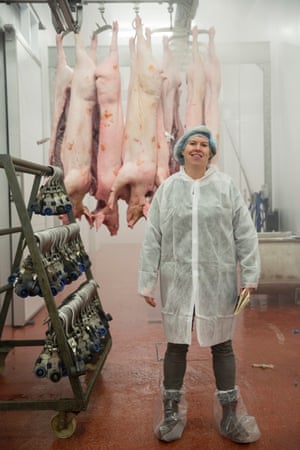
Before we follow the line back to where the pigs are processed we go into one of two enormous fridges, where I guess about 200 pigs are cooling down – the rule is 16 hours from kill to chill for transportation. Again, I do a little soul-searching to see how I was feeling and so far feel is it more awesome than gruesome. But really, so far this is nothing more than a big walk-in fridge like you see at the back of your butchers. The tour we are about to start is the heart of the matter.
We turn the corner and I’m instantly alive to the situation: the noise of machinery (thankfully none of animals), the 30 or so men busily working on platforms on the pig line (as opposed to the beef line, which runs down the other side of the room), and above all the constant passing of split pigs at head height. We’ve hit the nerve centre of the operation.
The order of service, as it were, is that the pigs are gassed in a rotating chamber that holds 10 animals, then they slide down a chute, hooked up by the heel and attached to an overhead pulley system that will ultimately deliver them into refrigerated trucks for transport. They are then bled over a large concrete drainage area, deposited into a bloody great machine that tumbles them for a good few minutes to get their hair off and then rehooked up. And this is where the serious work starts: first off a worker with a gas-gun gives the cadavers a once-over to burn off any hair. “That bit always reminds me of The Deer Hunter,” Pentelow says cheerfully, pulling out his regulation earplugs. Next up they go through a Mr Ben-type curtain and come out the other side as clean, pink pigs. Less than 10 minutes ago they were alive, five minutes ago they looked like dead animals, now they look like meat.
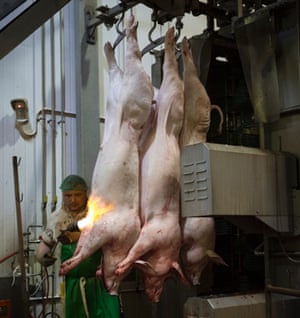
As the pigs pass down the line, the first guy makes a perfect cut from the base of their throat to near their genitalia. The next deftly lifts out a tumbling mess of grey-with-a-hint-of-mauve intestines and drops them down a chute onto a conveyor belt. The next couple of lads remove the offal – liver, heart, lungs, kidneys – as carefully as they are quick. These dark, bloody pieces are then hung by hand onto a bit of kit that I can only describe as the most macabre looking set of hooks you’ve ever seen. They’re checked by the meat inspector before being separated into different plastic containers. The carcasses are now cleaned out and good to go; they get a final looking-over and sign-off by another meat inspector before leaving for the chillers.
Still working towards life we reach the Rubicon – the enormous bloodletting area behind the gassing machine. We walk across it, dodging the pigs overhead that have just plonked down the chute which leads out of the back of it. And now for the first time I can hear squeals. Quite a lot of them to be honest, but I know enough about pigs to know they are always chatty, vociferous animals and although I am listening for distressed pig noises I can’t in truth make any out. But here they are; a hundred or so pigs in what is called “lairage”, or holding pens, where they spend a maximum of 60-90 minutes. From there the animals are trotted along in single file up a ramp and into a stall that is one of 10 that continually rotate. As the stalls go round they enter into an area of highly concentrated CO2, which being denser than air sinks to the bottom. So 90 seconds later they’re dead and they leave via the helter-skelter chute to be hung up and bled.

“We do 4,000-4,500 pigs a week, whereas the super-abattoirs can do 6,000 a day. One of the biggest now is Cranswick, not far from us in Norwich. They’re a limited company listed on the stock exchange with an annual turnover of £740m,” says Pentelow. We all know how much meat we eat in this country, so clearly there’s money to be made on that journey.
But the reason Heywood’s farm chose to work with the Burrows abattoir, and one of the reasons we went with Dingley, was not because they’re a mid-size independent, but because of how they kill their pigs. “We gas-stun in a high concentration of CO2 as opposed to the traditional method of pronging, which serves two purposes: firstly it’s considerably more humane as the pigs don’t get as stressed as when they are pronged. And secondly, because of this, there’s a lot less damage to the carcass: with stun-pronging you can expect 10% carcass damage, with gas stunning it’s less than 1%.”
Gas stunning costs on average £1 a pig more than pronging, and when you consider the price for processing a pig at their abattoir is £18.50, it is a sizeable fraction of the cost. With that in mind, that reasons why Heywood and the Burrows brothers are convinced and committed to their process are a combination of humanity and quality. As Heywood says: “You want to be doing the right thing by them at the time of slaughter.” This is from the man I’ve never seen approach one of his 7,000 pigs without an almost affectionate “Hello, girl!”
All of which is almost laudable, as it’s the economics of abattoirs that have seen mass-consolidation of the industry over the last 20 years. After the BSE and foot-and-mouth epidemics, the rules around slaughter got understandably much more stringent. British Retail Consortium (BRC) accreditation got tougher with ever-higher standards and tougher auditing (for which the abattoir pays £1,500). According to Pentelow, the retailers (ie supermarkets) also come in and demand their own set of regulations too, audits for which also come at a premium. “Having a full-time vet and a full time meat inspector is now a legal requirement,” says Pentelow, “even if you were only going to run 100 animals a week. We run through roughly 6,000 per week, and we are legally required to have three meat inspectors and a vet here at all times.” Even though each slaughterhouse is only responsible for 50% of their wages, the economies of scale are really against the little guys.

Because of the possible contamination of the food chain, getting rid of the bits that there isn’t a market for is an expensive business. Pig’s blood (and each pig has approximately six litres) is taken away from CK at the rate of £100p/tonne, and is then dried by a company in Doncaster, made into pellets and used to fuel power stations. Another big cost is keeping the operation clean, which takes 100 tonnes of water a day alone. He estimates that it costs them £3m a year to just run CK meats.
“It’s only going one way for sure,” says Heywood, “which is to bigger and fewer abattoirs. The only thing that could ever change that is if the consumer demanded it.” Sounds like the beginning of a campaign, I think, but then much as I like the idea of a small independent killing my meat as opposed to a huge corporate slaughterhouse, on reflection there are two things I care more about: animal welfare and food safety. And so if there are to be any changes in the evolution of abattoirs in this country I’d like to see more going towards gas stunning and less use of barbaric-looking and unreliable pronging. And I wonder what the food-labelling sticker would look like for that?


Recent Comments